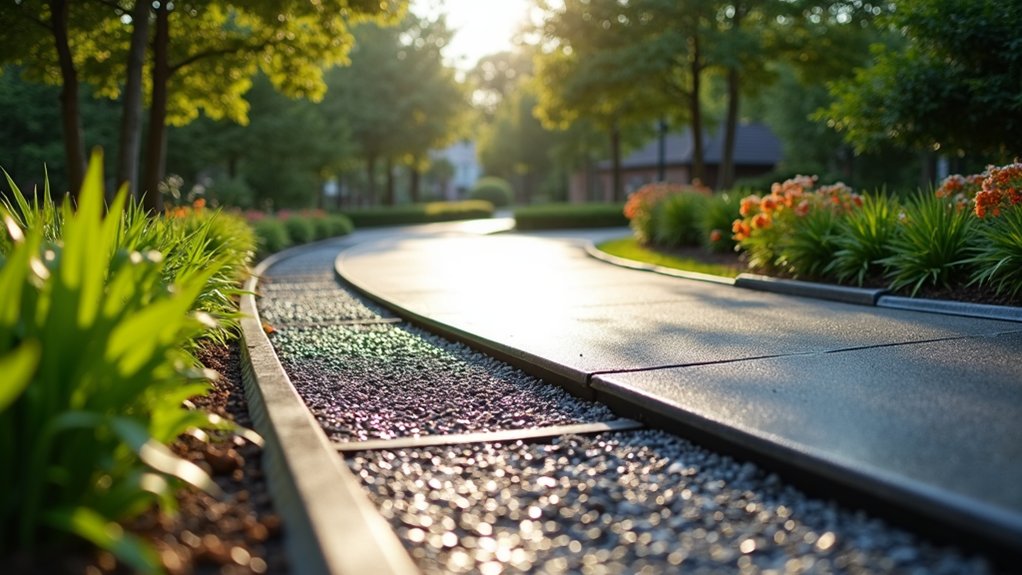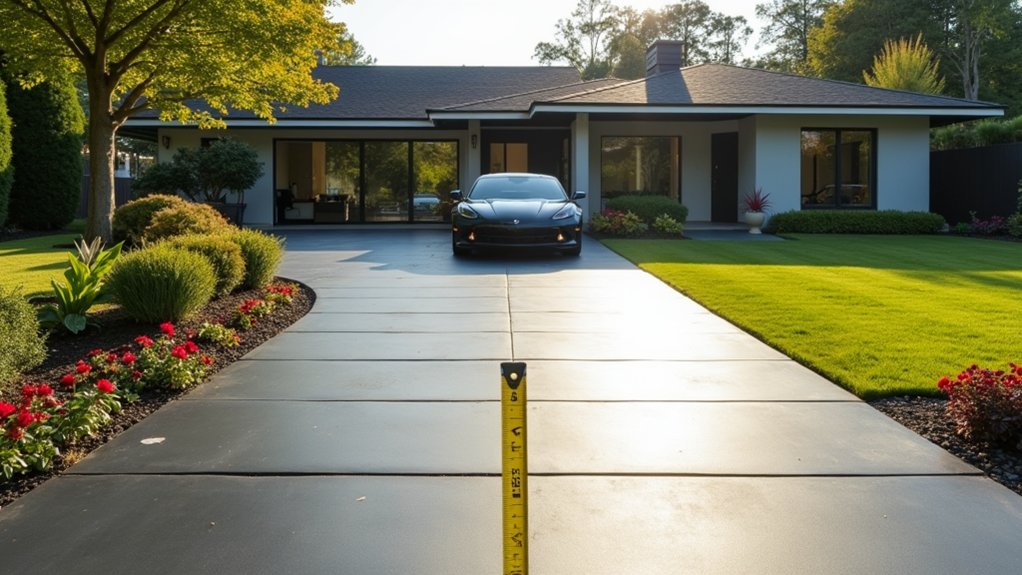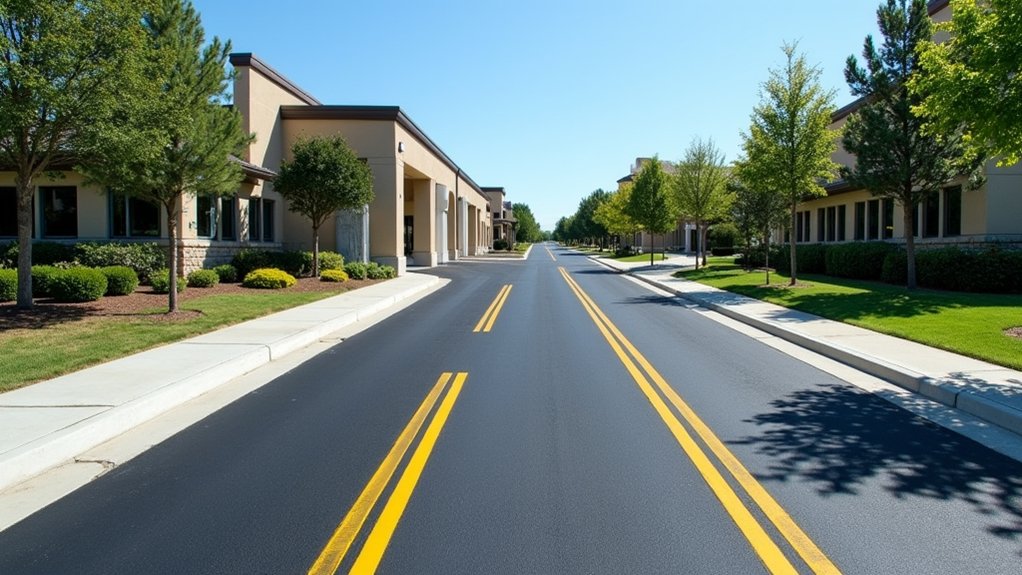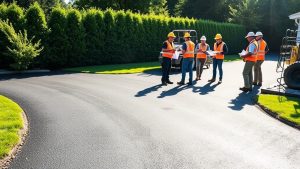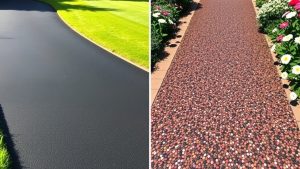When planning drainage for commercial driveways in the UK, it’s essential to secure local drainage permits and adhere to guidelines for culvert installation. Aim for a slope of 1% to 2% to ensure effective water flow, and consider using permeable materials to improve water absorption. Regular inspections are vital; check low-traffic systems every 3 to 5 years and more frequently for high-traffic areas, ideally annually. Your design should prioritise safety and visibility while complying with environmental regulations. Implementing these best practices can significantly enhance the efficiency of your drainage system.
Table of Contents
ToggleKey Takeaways
- Secure the necessary drainage permits from your local council and adhere to installation guidelines to prevent delays and additional costs.
- Ensure a slope of 1% to 2% for effective drainage towards outlets, utilising suitable surface drainage systems.
- Consider Sustainable Drainage Systems (SuDS) and use permeable materials to manage stormwater effectively and minimise runoff.
- Regularly check and maintain your drainage systems to avoid blockages and ensure they function properly.
- Design driveways with safe access in mind, ensuring good visibility and appropriate entry angles for smooth traffic flow.
Regulatory Requirements for Driveway Drainage
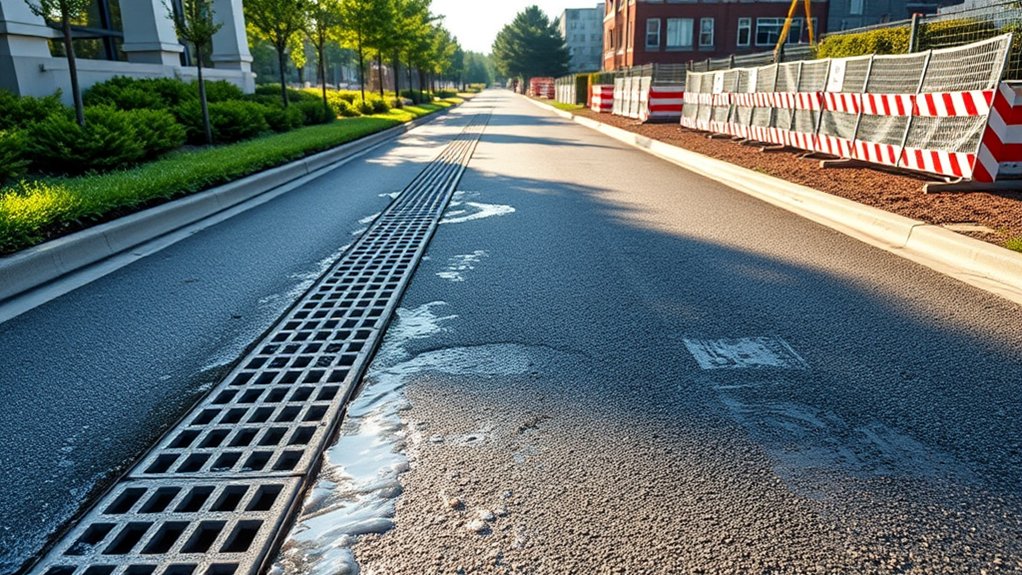
When building a commercial driveway in the UK, it’s essential to be aware of the regulatory requirements that can affect your project’s timeline and design. Before you start, you’ll need to secure drainage permits from local councils or relevant authorities, as construction can’t begin without these approvals. Permit applications typically require detailed drainage and grading plans to ensure they meet local standards. For instance, if you’re installing a culvert, you must follow specific guidelines regarding materials and installation methods set by transport authorities. You should also take into account the geometry and spacing of the driveway to ensure safe traffic flow and proper drainage, including maintaining sufficient sight distance for safe vehicle entry onto highways. Failing to comply with these regulations can lead to costly delays or the need for corrections, so thorough preparation is key for a smooth project.
Design Best Practices for Effective Drainage
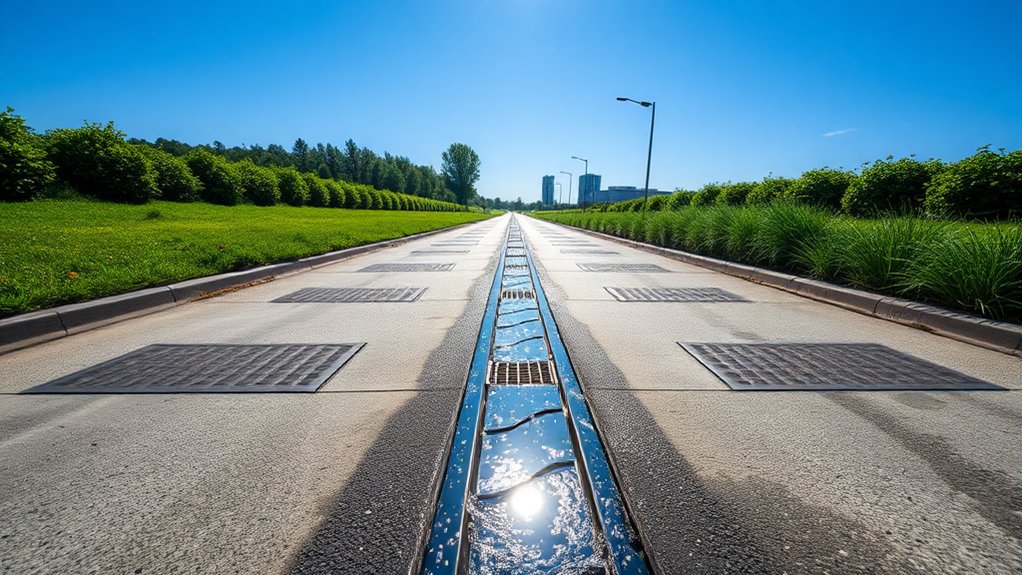
For effective drainage, focus on proper maintenance, erosion control, and well-designed culverts and ditches. Each aspect is crucial in managing water flow and safeguarding your driveway and nearby areas. For instance, regular clearing of debris from drains can prevent blockages and flooding. Incorporating a French Drain System can further enhance drainage efficiency by capturing and redirecting surface water. Additionally, implementing Sustainable Drainage Systems can provide long-term solutions to manage stormwater effectively.
Positive Drainage Maintenance
Effective positive drainage maintenance relies on the careful design and implementation of best practices to ensure water flows away from driveway surfaces efficiently.
To address drainage issues, check that your driveway has a slope of 1% to 2% to guide water towards designated outlets. Consider installing surface drainage systems such as channel drains and French drains, which effectively intercept and divert water. Additionally, proper driveway drainage is essential for preventing flooding, erosion, and damage to driveway surfaces. Implementing a permeable driveway can further enhance water management capabilities and support groundwater recharge.
Regular inspections twice a year are vital; clear away debris and check for clogs to maintain proper flow.
Using permeable paving materials can improve water absorption, while landscaping features can also aid drainage.
These maintenance practices not only extend the life of your driveway but also help prevent costly flooding problems down the line.
Erosion Control Techniques
Maintaining proper drainage is essential for the longevity of your driveway, but effective erosion control techniques are just as crucial.
Use vegetative barriers, such as native plants with deep roots, to stabilize soil and reduce runoff. During construction, temporary seeding and mulching can protect the soil.
Incorporate structural measures like silt fences or sediment basins to filter sediment from runoff.
Check dams and small berms can slow down water flow, helping to minimize erosion. Ensure your site grading directs water away from vulnerable areas, and consider using geotextiles or erosion control blankets for added soil stability.
Regular monitoring will help you quickly identify and address any weak spots in your erosion control efforts. Additionally, implementing proper drainage systems is vital to prevent flooding and maintain the integrity of your driveway.
Culvert and Ditch Design
When designing culverts and ditches for effective drainage, it’s crucial to consider site-specific factors that affect water flow and soil stability. Conducting a hydraulic analysis is key to determining the most suitable shapes and dimensions for culverts to manage water discharge effectively.
| Design Consideration | Best Practice |
|---|---|
| Culvert Shape | Choose based on flow type (supercritical/subcritical) |
| Material | Opt for corrugated metal or reinforced concrete for longevity |
| Slope | Keep a maximum slope of 6:1 for stability |
Pay attention to the entrance design to enhance flow capacity and reduce head loss. Ensure outlet velocities are controlled to prevent downstream erosion, making design adjustments as needed for efficient drainage management.
Essential Drainage Infrastructure Components
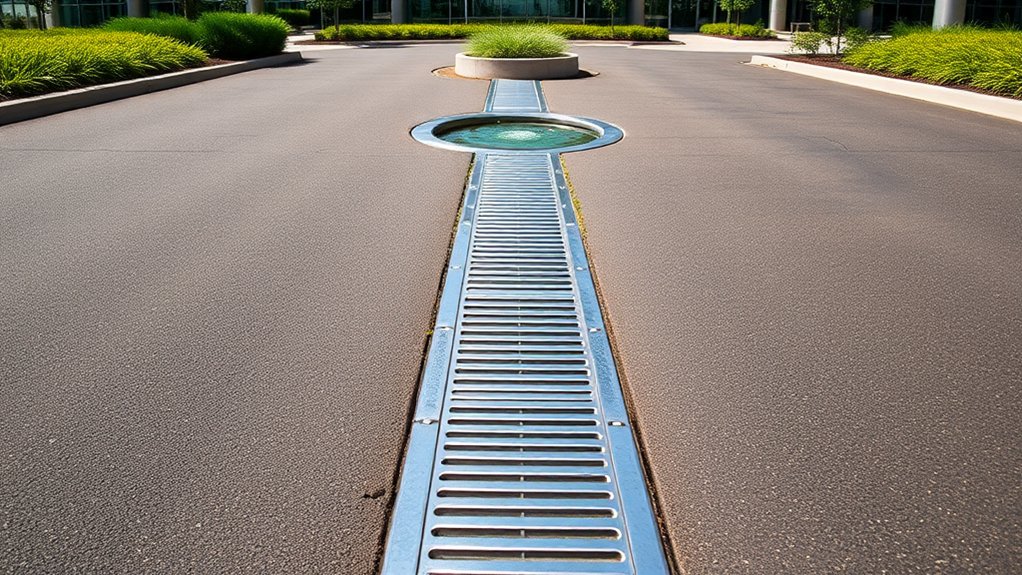
To ensure optimal performance in commercial drainage systems, it’s vital to grasp the key components that enhance their effectiveness.
Trench drains, equipped with grates, manage water flow and improve safety. Drainage channels serve as the backbone, capable of handling varying volumes and loads, particularly from vehicles.
Catch basins are crucial for collecting sediment and debris, while integrated debris baskets make maintenance easier. Storm sewers and street gutters efficiently transport stormwater underground, directing runoff to appropriate inlets.
Open channels and swales help store peak flows, and infiltration trenches assist in reducing surface runoff.
Together, these elements ensure your drainage system functions effectively, maintaining proper water flow and safeguarding your commercial property from flooding.
Safety and Visibility Considerations for Driveways
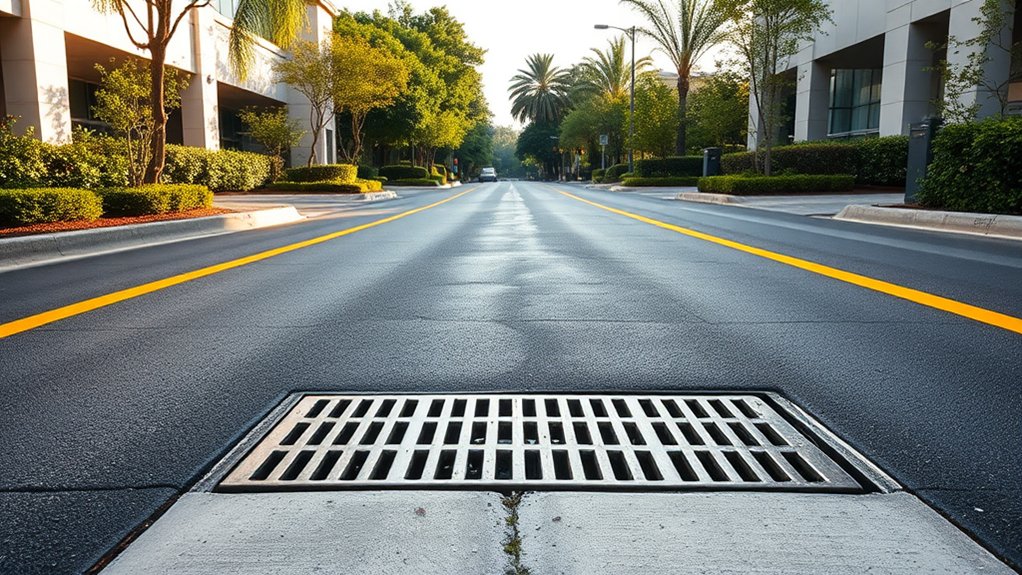
Safety and visibility are crucial when designing commercial driveways. Poor sight lines and misalignment can create dangerous situations.
Ensure that driveways are positioned on suitable road alignments with gentle gradients, steering clear of sharp bends or steep inclines. Aim for a sight distance of around 170 metres to the left and 150 metres to the right for roads with a speed limit of 80 kph to improve visibility.
The geometry of the driveway is equally important; entry angles should be 45 degrees for one-way access and at least 60 degrees for two-way access.
Keep a minimum corner clearance of 3.6 metres and ensure at least 7.3 metres between adjacent driveways to minimise traffic conflicts.
Regular maintenance of vegetation is necessary to maintain clear sight lines for all road users.
Environmental Impact and Stormwater Management
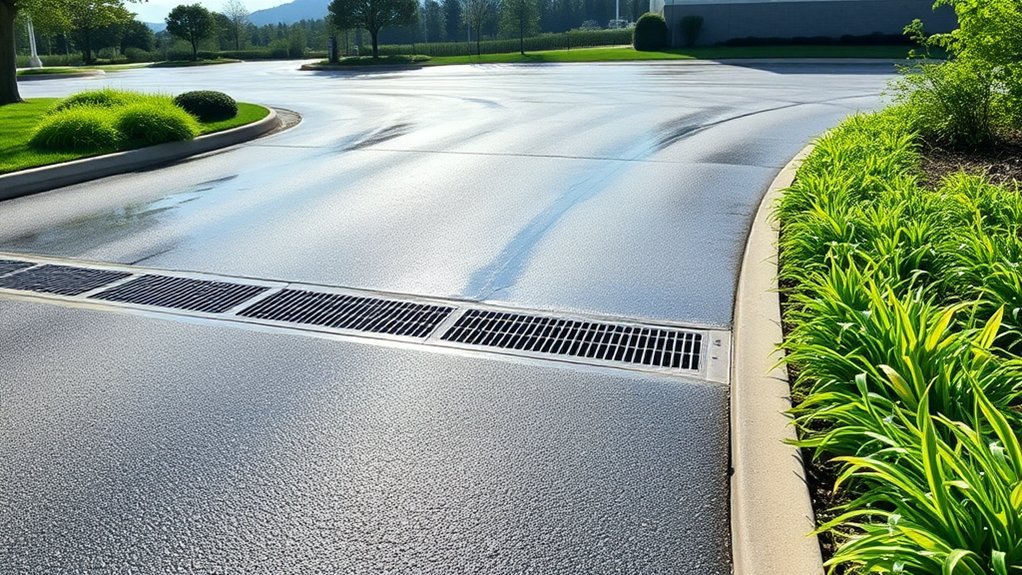
Effective environmental impact and stormwater management are crucial for commercial driveways, as they significantly affect the local ecosystem and water quality. Implementing a Stormwater Pollution Prevention Plan (SWPPP) is key to controlling runoff pollution and ensuring compliance with UK regulations.
Using best management practices (BMPs) for stormwater filtration helps capture and treat contaminants before they reach natural water bodies, which aids in ecological preservation.
Your design should aim to replicate or improve predevelopment runoff characteristics to reduce flooding risks and prevent stream erosion. It’s important to maintain groundwater recharge volumes and incorporate erosion control measures to protect public health and the various uses of local watersheds.
Maintenance of Drainage Systems
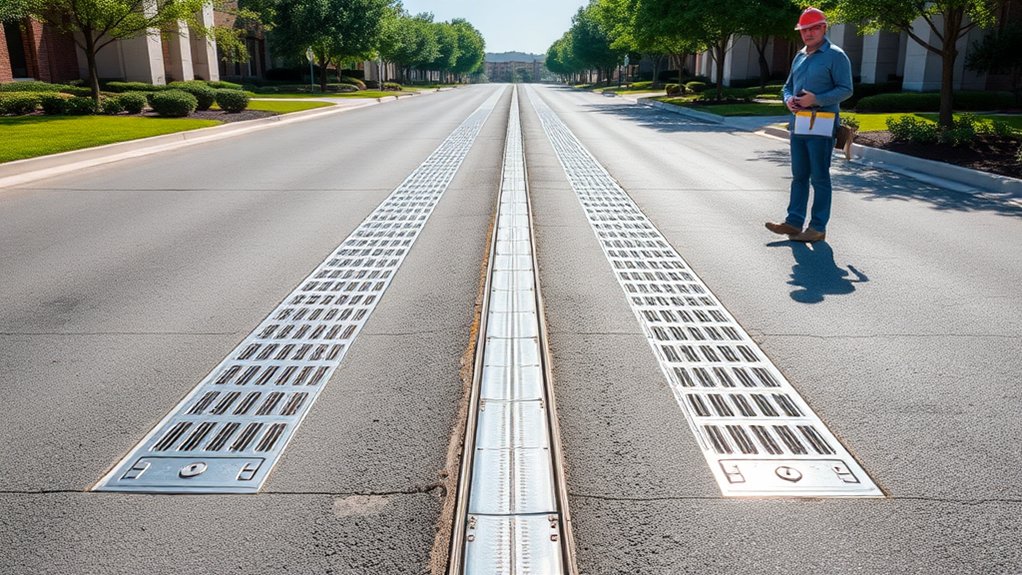
To ensure your drainage systems work effectively, inspect them at least twice a year and after heavy rainfall to spot any issues.
It’s vital to implement proper erosion control measures to maintain water flow and protect your driveway from damage.
Regular checks can help you tackle potential problems early, keeping your infrastructure safe and sound.
Regular Inspection Frequency
Regular inspections of drainage systems are crucial, with the frequency depending on usage and environmental factors. For light-use commercial systems, inspections should be scheduled every 3-5 years.
Properties with moderate usage, such as small hotels, require inspections every 2-3 years. Heavily used facilities should have annual inspections due to higher wastewater output.
Employing effective techniques like video camera assessments can uncover up to 70% of blockages that aren’t visible from the surface.
Additionally, regular maintenance, such as weekly checks for debris around drainage grates and monthly inspections of sink traps, is vital for optimal function.
Tailored assessments can help determine suitable inspection intervals for your specific commercial environment, ensuring your drainage system remains efficient and reliable.
Erosion Control Measures
To effectively manage drainage systems and control erosion, a proactive approach is essential, particularly after inspections.
Start by clearing debris from gutters, downspouts, and catch basins to ensure water flows freely. Regularly use high-pressure water jet flushing to prevent sediment from building up, which can cause erosion.
Be mindful of vegetation management; avoid planting large plants near drainage lines as they can obstruct flow and contribute to erosion.
For gravel surfaces, consider using geotextile fabric underneath to stabilise soil and reduce runoff-related erosion.
It’s crucial to regularly inspect and repair any damage to pipes and fittings, ensuring proper grading for efficient water flow.
Lastly, smart sensors can be beneficial for monitoring flow rates, allowing for timely maintenance and further reducing the risk of erosion.
Compliance Monitoring and Assessment
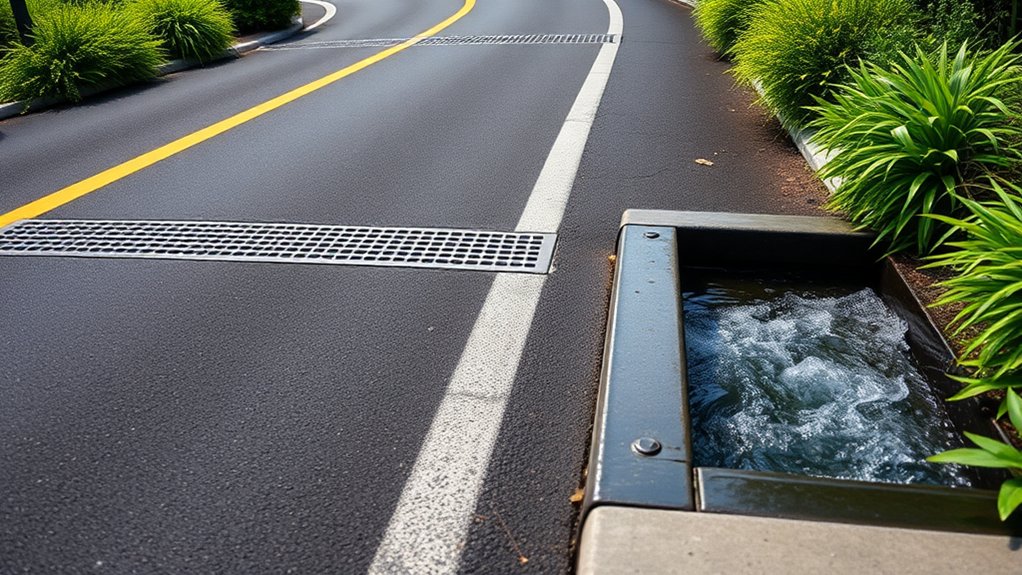
Compliance monitoring and assessment are crucial for effective stormwater management, and they necessitate a systematic approach to ensure adherence to regulatory standards.
Implement robust monitoring methods, such as regular and event-triggered sampling, to gather data on pollutants at discharge points. Establish compliance metrics to assess performance against benchmark concentrations, employing both visual inspections and laboratory analyses.
Be prepared for inspections by local authorities, who may visit your property to evaluate stormwater discharge compliance. Keep detailed records of monitoring data, inspection results, and any corrective actions taken.
Timely reporting of findings is vital to demonstrate compliance with NPDES permit conditions and avoid enforcement actions. By adopting these practices, you can ensure effective compliance and safeguard water quality.
Key Takeaways for Commercial Driveway Drainage
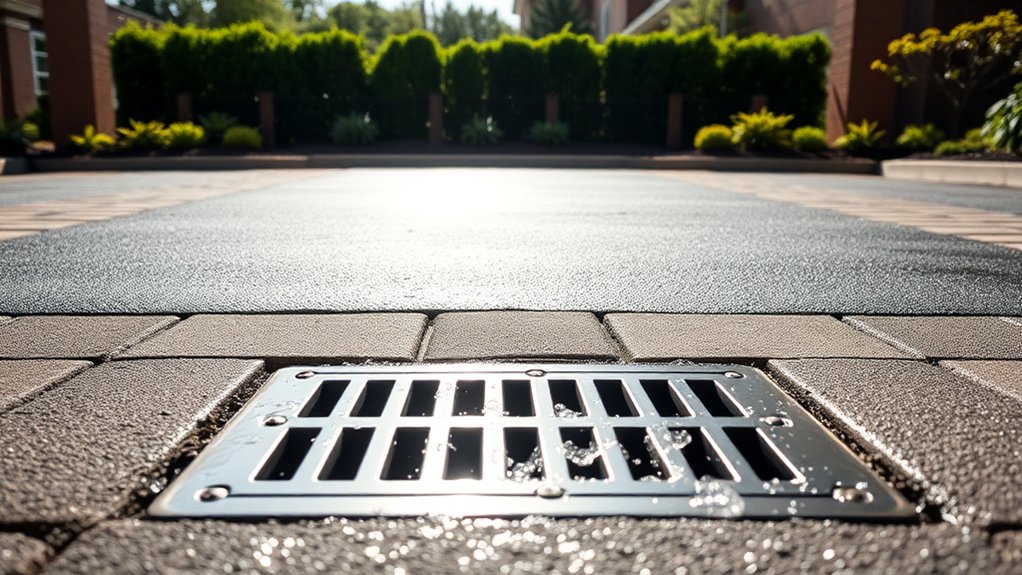
Effective commercial driveway drainage relies on several key factors that impact water management and the longevity of the surface.
Firstly, identify potential drainage challenges and select suitable systems, such as trench, French, or channel drains, to manage runoff effectively. Ensure proper slope and grading, aiming for a gradient of 1% to 2% to facilitate drainage and reduce pooling.
Choose your surface materials carefully; options like porous concrete or gravel can improve drainage while maintaining durability. A well-constructed, permeable base is crucial for allowing water flow and preventing structural problems.
Lastly, consider landscaping techniques to direct water away from the driveway, ensuring ongoing effective water management.
Frequently Asked Questions
What Are the Costs Associated With Commercial Driveway Drainage Construction?
When assessing the costs of a drainage system for your commercial driveway, consider installation expenses such as excavation, materials, and labour. For example, hiring a skilled contractor may cost more initially, but can save you on future repairs. These factors can significantly affect your budget, so plan carefully to ensure effective drainage solutions for your driveway.
How Can I Determine My Property’s Drainage Needs?
To determine your property’s drainage needs, start by evaluating the land. Look for areas where water collects, assess the slope of the ground, and check existing drainage features like gutters and drains. For example, if you notice puddles forming after heavy rain, that’s a sign you may need to improve drainage in that area. This thorough assessment will help you identify the specific requirements for effective drainage on your property.
Are There Specific Materials Recommended for Driveway Paving?
For driveway paving, consider using permeable materials that improve drainage. Options such as porous asphalt or permeable block paving effectively manage water runoff and reduce erosion. This not only enhances functionality but also extends the lifespan of your commercial driveway.
What Is the Typical Timeline for Obtaining Drainage Permits?
When managing the permit processing, expect timelines to vary. Factors such as the complexity of the application, reviews by local authorities, and potential revisions can extend the process. Generally, it can take anywhere from 10 days to several weeks before you receive final approval.
How Can I Appeal a Denied Drainage Permit Application?
To appeal a denied drainage permit application, follow the reconsideration process. Submit the necessary documentation, including your reasons for appeal and any alternative conditions, within the specified timeframe. This ensures your application meets drainage permit requirements and receives proper consideration. For instance, if your initial application was rejected due to insufficient drainage design, providing a revised plan could strengthen your case.
Conclusion
In commercial driveway drainage, following regulations and best practices is crucial for success. Your drainage system is essential for directing stormwater away, which helps prevent costly erosion and reduces liability. By investing in key components and prioritising regular maintenance, you’ll meet legal requirements and enhance safety and environmental responsibility. A well-drained driveway is not just important; it’s the cornerstone of a successful commercial property.
Learn about driveway width regulations and discover the essential requirements that could affect your property—find out how wide your driveway Read more
Planning a commercial driveway for heavy traffic requires careful consideration of key factors—discover essential design strategies that can elevate your Read more
Learn why effective drainage is crucial for driveways and discover the regulations and best practices that could save you costly Read more

